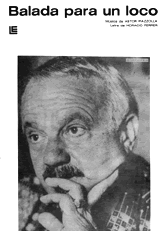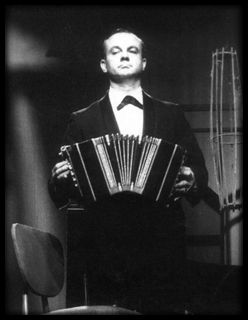By
An atomic bomb, “Balada para un loco”

don’t remember when I heard it for the first time. Maybe it was on a cultural radio, because on the others, no broadcaster would have had the idea of airing it. The starting recitation, said by the singer, charmed me: «Las tardecitas de Buenos Aires tienen ese qué sé yo, ¿viste? Salís de tu casa, por Arenales. Lo de siempre: en la calle y en vos… cuando, de repente, detrás de un árbol, me aparezco yo...».
Those were the days when I was more interested in listening to Mercedes Sosa, Los Quilapayún, perhaps a little bit to Serrat. And, of course, at the end of the year, the tropical music of Los Hispanos and Los Graduados. As for tangos, I had assimilated them, unconsciously, by frequently hearing them at the corner cafes in Bello and Medellín. I did not know then that that tremendous music, about underground areas, unrequited loves, existential despair and neighborhoods, was waiting for us. It allowed us to grow and keep memories.
 The singer went on with his deep voice and his perfect vocalization: «Mezcla rara de penúltimo linyera y de primer polizonte en el viaje a Venus: medio melón en la cabeza, las rayas de la camisa pintadas en la piel, dos medias suelas clavadas en los pies, y una banderita de taxi libre levantada en cada mano...». «Hey! —I said to myself—, this is pure surrealism». I already had notions about it, due to the discussions in the University of Antioquia about art and literature, Marxism, the French May about which we came to know lately and some superficial reading of Breton’s work. «It seems that I’m dreaming», I added.
The singer went on with his deep voice and his perfect vocalization: «Mezcla rara de penúltimo linyera y de primer polizonte en el viaje a Venus: medio melón en la cabeza, las rayas de la camisa pintadas en la piel, dos medias suelas clavadas en los pies, y una banderita de taxi libre levantada en cada mano...». «Hey! —I said to myself—, this is pure surrealism». I already had notions about it, due to the discussions in the University of Antioquia about art and literature, Marxism, the French May about which we came to know lately and some superficial reading of Breton’s work. «It seems that I’m dreaming», I added.
The song continued and its lines wallowed in my head. I did not understand some words, like «piantao, piantao, piantao…», and as for the moon (I perceived as a balloon) that rolled along Callao. But other phrases astonished me: «cuando anochezca en tu porteña soledad». (When it gets dark in your porteña loneliness). The music and the voice passed but I was caught. It was like a revelation. I had the intention to get it but later my purpose fell into oblivion. A postponement.
One day, maybe in the late seventies, a music student in the University of Antioquía was playing it on a flute. I was struck. When she finished I asked her if she had the lyrics. The following day she gave it to me. She also gave me some volcanic information: she owned the recording by Amelita Baltar with Astor Piazzolla. She made me a copy on a cassette tape. And then there was no way of detaching me from the lyrics of the Uruguayan Horacio Ferrer and the music of the composer of “Adiós Nonino”.
In fact, “Balada para un loco” was the last boom of tango-song. It did not win the day of its premiere at the Festival de la Canción y de la Danza, organized by the Municipalidad de la Ciudad de Buenos Aires, in November 1969. It won the second prize, the first was for “Hasta el último tren”, by Julio Camilloni and Julio Ahumada, sung by Jorge Sobral. Part of the audience did not like Amelita Baltar’s hoarse (sensual, say some) voice and so they threw coins and other objects at her. Thereafter somebody said that there was some kind of sabotage, promoted by some enemies of Piazzolla.
The same week of its introduction into society, a single disc with the revolutionary piece was recorded and on the B-side was “Chiquilín de Bachín”, also by Astor and Horacio. Two hundred thousand records were sold immediately.
 One day in 1984, after an oneiric evening at the Bar La Boa, in Medellín, we went out at midnight, sailing on a drunken ship. I was with the sculptor Gabriel Restrepo and the journalist Armando Villa (rip), stumbling along the downtown streets. And the three of us went down along La Playa and turned along Junín, singing like a choir (to be polite) the “Balada para un loco”. Certainly, we were shouting to the top of our lungs: «Ya sé que estoy piantao, piantao, piantao… / Yo miro a Buenos Aires del nido de un gorrión; / y a vos te vi tan triste… ¡Vení! ¡Volá! ¡Sentí!… / el loco berretín que tengo para vos: / ¡Loco! ¡Loco! ¡Loco! / Cuando anochezca en tu porteña soledad, / por la ribera de tu sábana vendré / con un poema y un trombón / a desvelarte el corazón».
One day in 1984, after an oneiric evening at the Bar La Boa, in Medellín, we went out at midnight, sailing on a drunken ship. I was with the sculptor Gabriel Restrepo and the journalist Armando Villa (rip), stumbling along the downtown streets. And the three of us went down along La Playa and turned along Junín, singing like a choir (to be polite) the “Balada para un loco”. Certainly, we were shouting to the top of our lungs: «Ya sé que estoy piantao, piantao, piantao… / Yo miro a Buenos Aires del nido de un gorrión; / y a vos te vi tan triste… ¡Vení! ¡Volá! ¡Sentí!… / el loco berretín que tengo para vos: / ¡Loco! ¡Loco! ¡Loco! / Cuando anochezca en tu porteña soledad, / por la ribera de tu sábana vendré / con un poema y un trombón / a desvelarte el corazón».
The first time I visited Buenos Aires (in 1993), one of the first things I did was to go, at night, to Callao Street to see the moon (although that night there was no moon at all) rolling along the asphalt, and, in fact, I saw it reflected on shop windows and I could not refrain myself: «Mirá que va la luna rodando por Callao», I shouted in the middle of the bewilderment of the passers-by. Another day I walked along Arenales but I had not enough time to visit the Vieytes madhouse to see if the mad people would applaud me.
On November 15, 1969, in Buenos Aires, at the Luna Park, an atomic bomb went off (it is a Piazzolla’s expression). A new way of writing tango was born. It was a poetical and musical hallucination. It was the avant-garde emergence of the urban surrealism in Latin America. Thirty years after the explosion, I interviewed Horacio Ferrer about this depth charge which his Balada means. «Why is it still in vogue?», I asked him. «Because it unfolds a romantic subject in a world of merchants», said he.
“Balada para un loco”, an outrageous succession to Breton, it is a landmark in the inclusion of new metaphors into the urban song, in tango, which goes on conquering devotees in the world after having lost at a festival. The first time I heard it Roberto Goyeneche was on vocals. He recorded it a few days after Amelita did it. It was also in 1969.
One would like, every time you hear it, to go running around cornices with a swallow in the engine and put on a half melon on your head (a bowler hat) and paint yourself with stripes of an unreal shirt. In Buenos Aires I found traffic lights with three light blue lights. They are traffic lights made only for flying.